Action Research for Special Educational Needs (SEN) Children - UV51238
VerifiedAdded on 2023/01/03
|14
|4851
|54
Homework Assignment
AI Summary
This assignment presents an action research study focused on children with Special Educational Needs (SEN). It begins by defining action research, its purpose, and key features, emphasizing its role in improving practices within healthcare and educational environments. The study analyzes the implications of action research models, specifically the Warner Burke model, and justifies the selection of SEN children as the area of practice. It outlines a clear intervention strategy, including identifying the research issue, conducting a literature review, selecting research methods, collecting and analyzing data, and drawing conclusions. The assignment also addresses ethical and political considerations, including confidentiality, and provides a detailed implementation plan with timelines. Furthermore, it evaluates various methods for action research, including questionnaires, interviews, and observations, along with methods for collecting and analyzing both qualitative and quantitative data, such as thematic analysis and inductive data analysis. The research aims to understand the challenges faced by SEN children and propose improvements to support their learning and development.
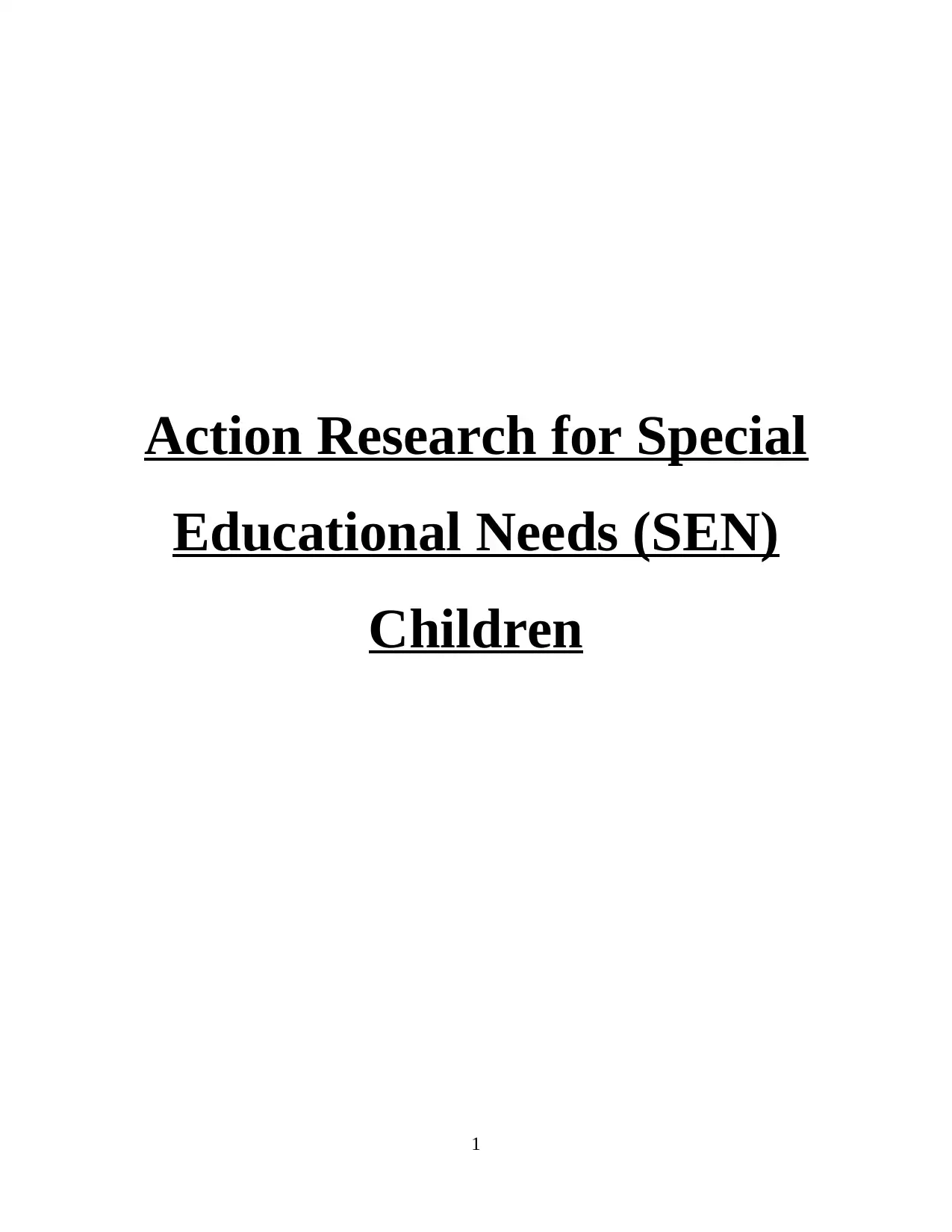
Action Research for Special
Educational Needs (SEN)
Children
1
Educational Needs (SEN)
Children
1
Paraphrase This Document
Need a fresh take? Get an instant paraphrase of this document with our AI Paraphraser
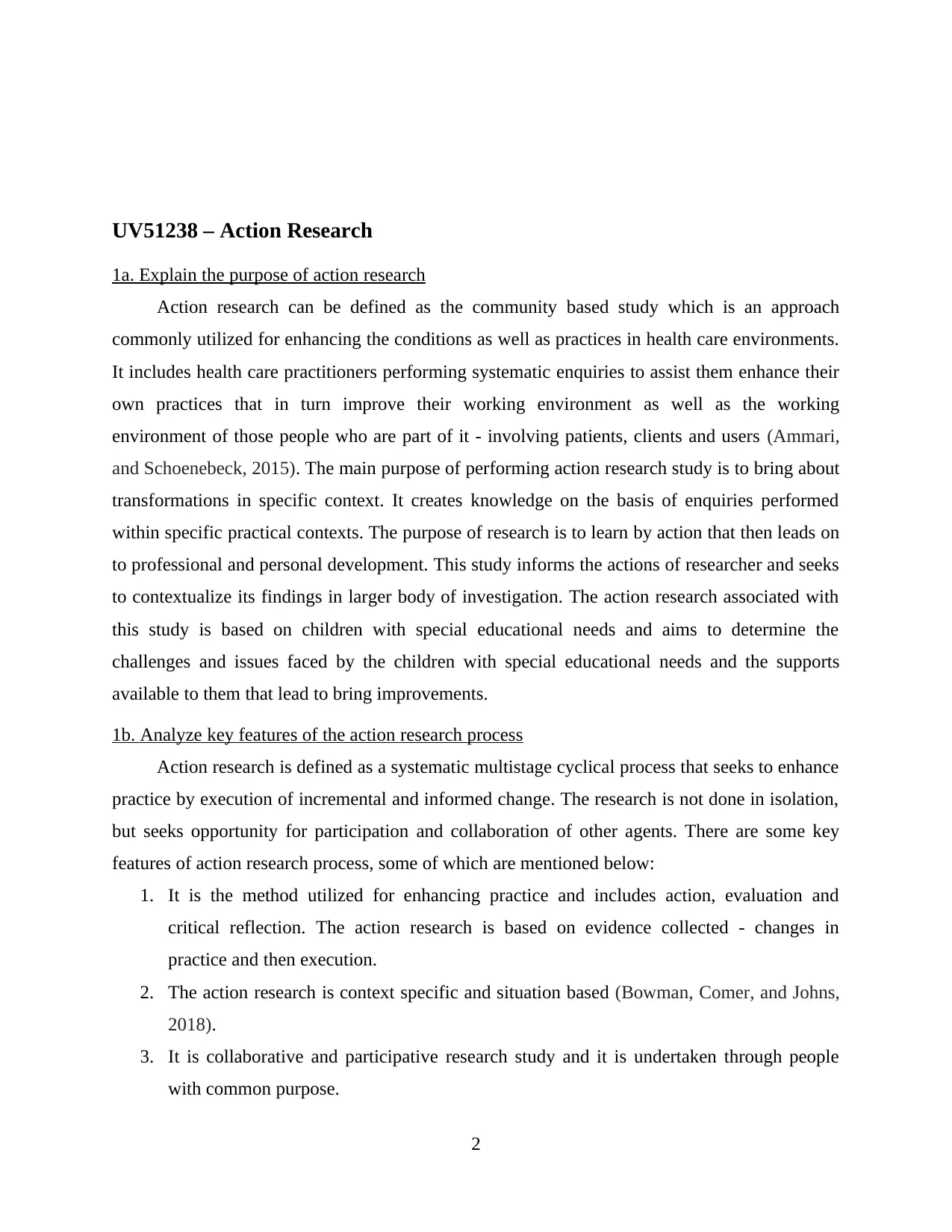
UV51238 – Action Research
1a. Explain the purpose of action research
Action research can be defined as the community based study which is an approach
commonly utilized for enhancing the conditions as well as practices in health care environments.
It includes health care practitioners performing systematic enquiries to assist them enhance their
own practices that in turn improve their working environment as well as the working
environment of those people who are part of it - involving patients, clients and users (Ammari,
and Schoenebeck, 2015). The main purpose of performing action research study is to bring about
transformations in specific context. It creates knowledge on the basis of enquiries performed
within specific practical contexts. The purpose of research is to learn by action that then leads on
to professional and personal development. This study informs the actions of researcher and seeks
to contextualize its findings in larger body of investigation. The action research associated with
this study is based on children with special educational needs and aims to determine the
challenges and issues faced by the children with special educational needs and the supports
available to them that lead to bring improvements.
1b. Analyze key features of the action research process
Action research is defined as a systematic multistage cyclical process that seeks to enhance
practice by execution of incremental and informed change. The research is not done in isolation,
but seeks opportunity for participation and collaboration of other agents. There are some key
features of action research process, some of which are mentioned below:
1. It is the method utilized for enhancing practice and includes action, evaluation and
critical reflection. The action research is based on evidence collected - changes in
practice and then execution.
2. The action research is context specific and situation based (Bowman, Comer, and Johns,
2018).
3. It is collaborative and participative research study and it is undertaken through people
with common purpose.
2
1a. Explain the purpose of action research
Action research can be defined as the community based study which is an approach
commonly utilized for enhancing the conditions as well as practices in health care environments.
It includes health care practitioners performing systematic enquiries to assist them enhance their
own practices that in turn improve their working environment as well as the working
environment of those people who are part of it - involving patients, clients and users (Ammari,
and Schoenebeck, 2015). The main purpose of performing action research study is to bring about
transformations in specific context. It creates knowledge on the basis of enquiries performed
within specific practical contexts. The purpose of research is to learn by action that then leads on
to professional and personal development. This study informs the actions of researcher and seeks
to contextualize its findings in larger body of investigation. The action research associated with
this study is based on children with special educational needs and aims to determine the
challenges and issues faced by the children with special educational needs and the supports
available to them that lead to bring improvements.
1b. Analyze key features of the action research process
Action research is defined as a systematic multistage cyclical process that seeks to enhance
practice by execution of incremental and informed change. The research is not done in isolation,
but seeks opportunity for participation and collaboration of other agents. There are some key
features of action research process, some of which are mentioned below:
1. It is the method utilized for enhancing practice and includes action, evaluation and
critical reflection. The action research is based on evidence collected - changes in
practice and then execution.
2. The action research is context specific and situation based (Bowman, Comer, and Johns,
2018).
3. It is collaborative and participative research study and it is undertaken through people
with common purpose.
2
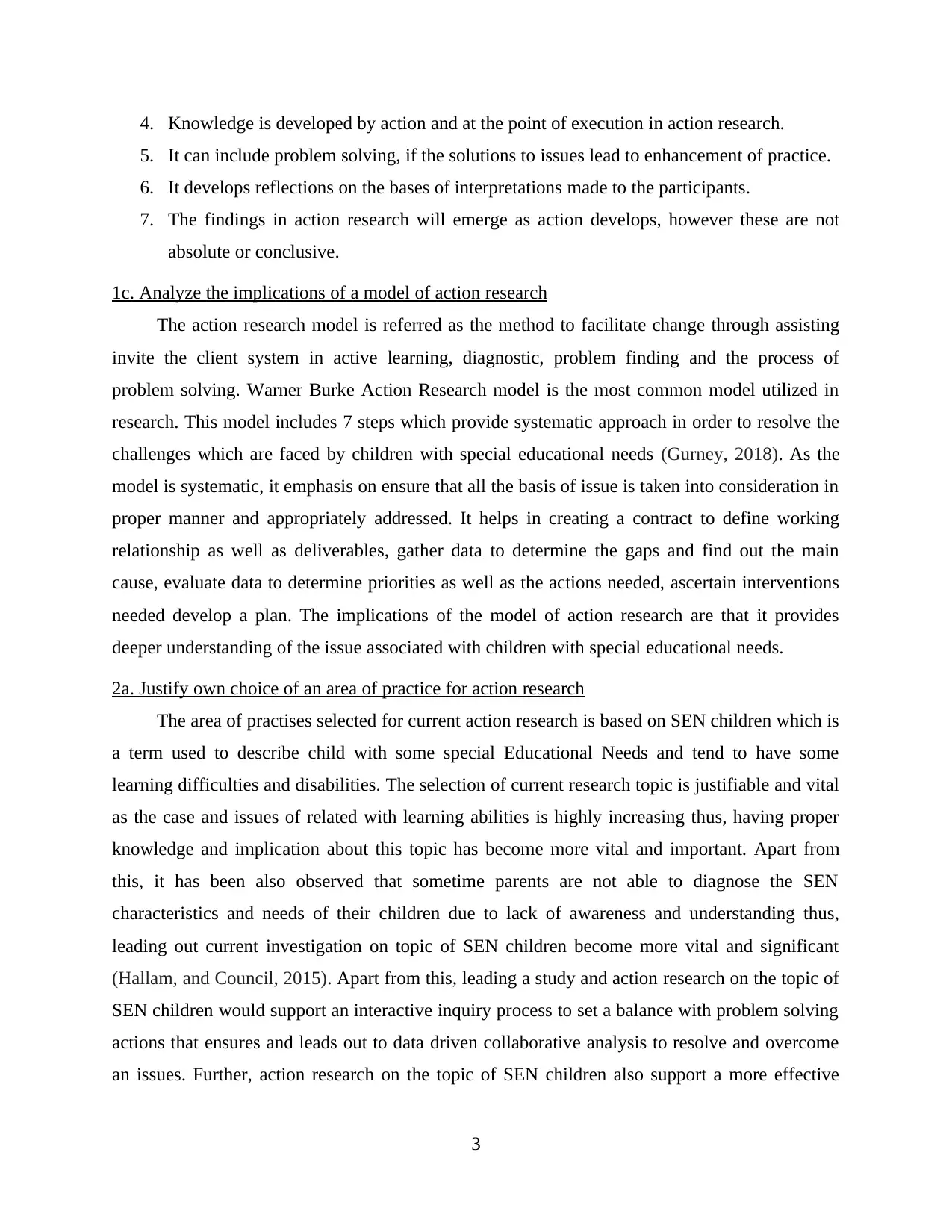
4. Knowledge is developed by action and at the point of execution in action research.
5. It can include problem solving, if the solutions to issues lead to enhancement of practice.
6. It develops reflections on the bases of interpretations made to the participants.
7. The findings in action research will emerge as action develops, however these are not
absolute or conclusive.
1c. Analyze the implications of a model of action research
The action research model is referred as the method to facilitate change through assisting
invite the client system in active learning, diagnostic, problem finding and the process of
problem solving. Warner Burke Action Research model is the most common model utilized in
research. This model includes 7 steps which provide systematic approach in order to resolve the
challenges which are faced by children with special educational needs (Gurney, 2018). As the
model is systematic, it emphasis on ensure that all the basis of issue is taken into consideration in
proper manner and appropriately addressed. It helps in creating a contract to define working
relationship as well as deliverables, gather data to determine the gaps and find out the main
cause, evaluate data to determine priorities as well as the actions needed, ascertain interventions
needed develop a plan. The implications of the model of action research are that it provides
deeper understanding of the issue associated with children with special educational needs.
2a. Justify own choice of an area of practice for action research
The area of practises selected for current action research is based on SEN children which is
a term used to describe child with some special Educational Needs and tend to have some
learning difficulties and disabilities. The selection of current research topic is justifiable and vital
as the case and issues of related with learning abilities is highly increasing thus, having proper
knowledge and implication about this topic has become more vital and important. Apart from
this, it has been also observed that sometime parents are not able to diagnose the SEN
characteristics and needs of their children due to lack of awareness and understanding thus,
leading out current investigation on topic of SEN children become more vital and significant
(Hallam, and Council, 2015). Apart from this, leading a study and action research on the topic of
SEN children would support an interactive inquiry process to set a balance with problem solving
actions that ensures and leads out to data driven collaborative analysis to resolve and overcome
an issues. Further, action research on the topic of SEN children also support a more effective
3
5. It can include problem solving, if the solutions to issues lead to enhancement of practice.
6. It develops reflections on the bases of interpretations made to the participants.
7. The findings in action research will emerge as action develops, however these are not
absolute or conclusive.
1c. Analyze the implications of a model of action research
The action research model is referred as the method to facilitate change through assisting
invite the client system in active learning, diagnostic, problem finding and the process of
problem solving. Warner Burke Action Research model is the most common model utilized in
research. This model includes 7 steps which provide systematic approach in order to resolve the
challenges which are faced by children with special educational needs (Gurney, 2018). As the
model is systematic, it emphasis on ensure that all the basis of issue is taken into consideration in
proper manner and appropriately addressed. It helps in creating a contract to define working
relationship as well as deliverables, gather data to determine the gaps and find out the main
cause, evaluate data to determine priorities as well as the actions needed, ascertain interventions
needed develop a plan. The implications of the model of action research are that it provides
deeper understanding of the issue associated with children with special educational needs.
2a. Justify own choice of an area of practice for action research
The area of practises selected for current action research is based on SEN children which is
a term used to describe child with some special Educational Needs and tend to have some
learning difficulties and disabilities. The selection of current research topic is justifiable and vital
as the case and issues of related with learning abilities is highly increasing thus, having proper
knowledge and implication about this topic has become more vital and important. Apart from
this, it has been also observed that sometime parents are not able to diagnose the SEN
characteristics and needs of their children due to lack of awareness and understanding thus,
leading out current investigation on topic of SEN children become more vital and significant
(Hallam, and Council, 2015). Apart from this, leading a study and action research on the topic of
SEN children would support an interactive inquiry process to set a balance with problem solving
actions that ensures and leads out to data driven collaborative analysis to resolve and overcome
an issues. Further, action research on the topic of SEN children also support a more effective
3
⊘ This is a preview!⊘
Do you want full access?
Subscribe today to unlock all pages.

Trusted by 1+ million students worldwide
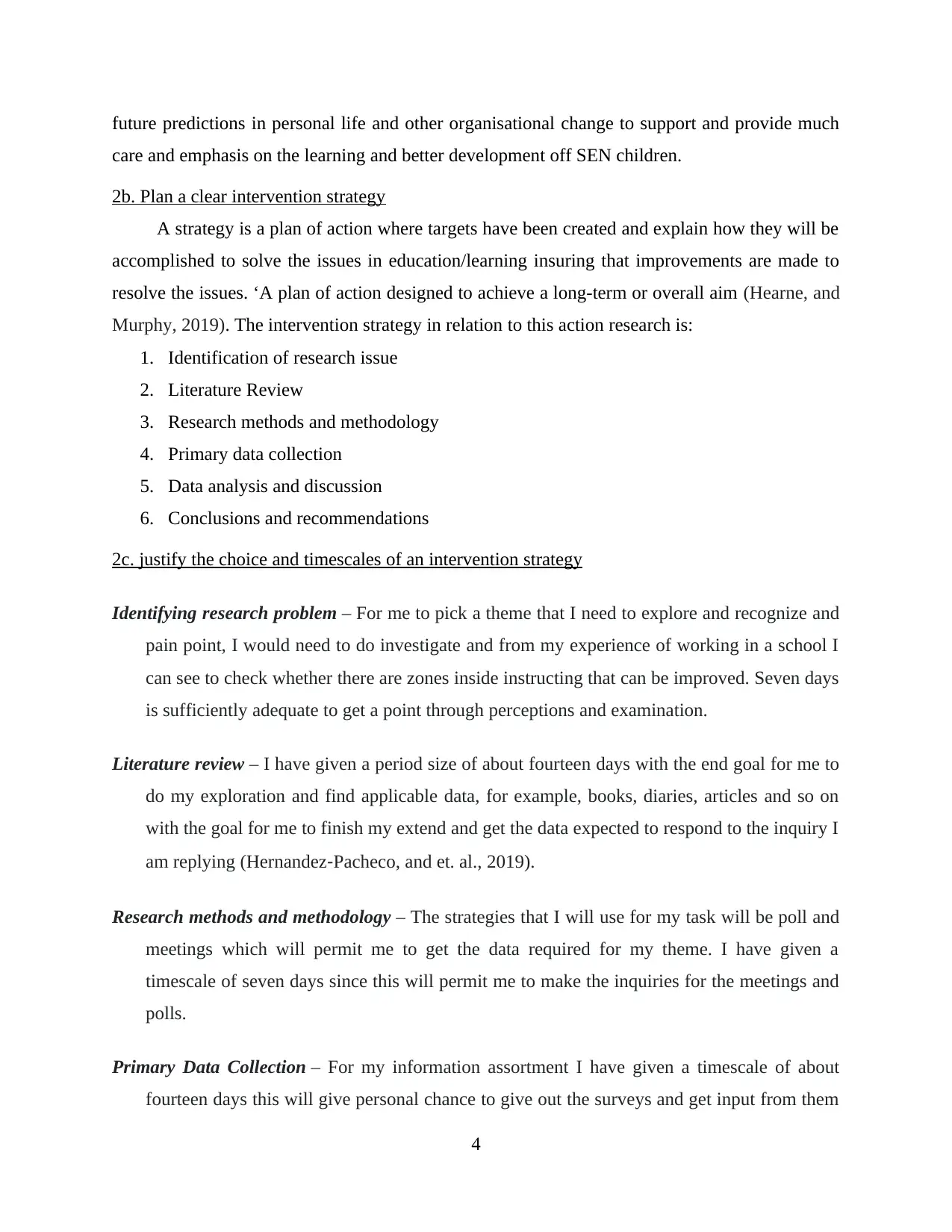
future predictions in personal life and other organisational change to support and provide much
care and emphasis on the learning and better development off SEN children.
2b. Plan a clear intervention strategy
A strategy is a plan of action where targets have been created and explain how they will be
accomplished to solve the issues in education/learning insuring that improvements are made to
resolve the issues. ‘A plan of action designed to achieve a long-term or overall aim (Hearne, and
Murphy, 2019). The intervention strategy in relation to this action research is:
1. Identification of research issue
2. Literature Review
3. Research methods and methodology
4. Primary data collection
5. Data analysis and discussion
6. Conclusions and recommendations
2c. justify the choice and timescales of an intervention strategy
Identifying research problem – For me to pick a theme that I need to explore and recognize and
pain point, I would need to do investigate and from my experience of working in a school I
can see to check whether there are zones inside instructing that can be improved. Seven days
is sufficiently adequate to get a point through perceptions and examination.
Literature review – I have given a period size of about fourteen days with the end goal for me to
do my exploration and find applicable data, for example, books, diaries, articles and so on
with the goal for me to finish my extend and get the data expected to respond to the inquiry I
am replying (Hernandez‐Pacheco, and et. al., 2019).
Research methods and methodology – The strategies that I will use for my task will be poll and
meetings which will permit me to get the data required for my theme. I have given a
timescale of seven days since this will permit me to make the inquiries for the meetings and
polls.
Primary Data Collection – For my information assortment I have given a timescale of about
fourteen days this will give personal chance to give out the surveys and get input from them
4
care and emphasis on the learning and better development off SEN children.
2b. Plan a clear intervention strategy
A strategy is a plan of action where targets have been created and explain how they will be
accomplished to solve the issues in education/learning insuring that improvements are made to
resolve the issues. ‘A plan of action designed to achieve a long-term or overall aim (Hearne, and
Murphy, 2019). The intervention strategy in relation to this action research is:
1. Identification of research issue
2. Literature Review
3. Research methods and methodology
4. Primary data collection
5. Data analysis and discussion
6. Conclusions and recommendations
2c. justify the choice and timescales of an intervention strategy
Identifying research problem – For me to pick a theme that I need to explore and recognize and
pain point, I would need to do investigate and from my experience of working in a school I
can see to check whether there are zones inside instructing that can be improved. Seven days
is sufficiently adequate to get a point through perceptions and examination.
Literature review – I have given a period size of about fourteen days with the end goal for me to
do my exploration and find applicable data, for example, books, diaries, articles and so on
with the goal for me to finish my extend and get the data expected to respond to the inquiry I
am replying (Hernandez‐Pacheco, and et. al., 2019).
Research methods and methodology – The strategies that I will use for my task will be poll and
meetings which will permit me to get the data required for my theme. I have given a
timescale of seven days since this will permit me to make the inquiries for the meetings and
polls.
Primary Data Collection – For my information assortment I have given a timescale of about
fourteen days this will give personal chance to give out the surveys and get input from them
4
Paraphrase This Document
Need a fresh take? Get an instant paraphrase of this document with our AI Paraphraser
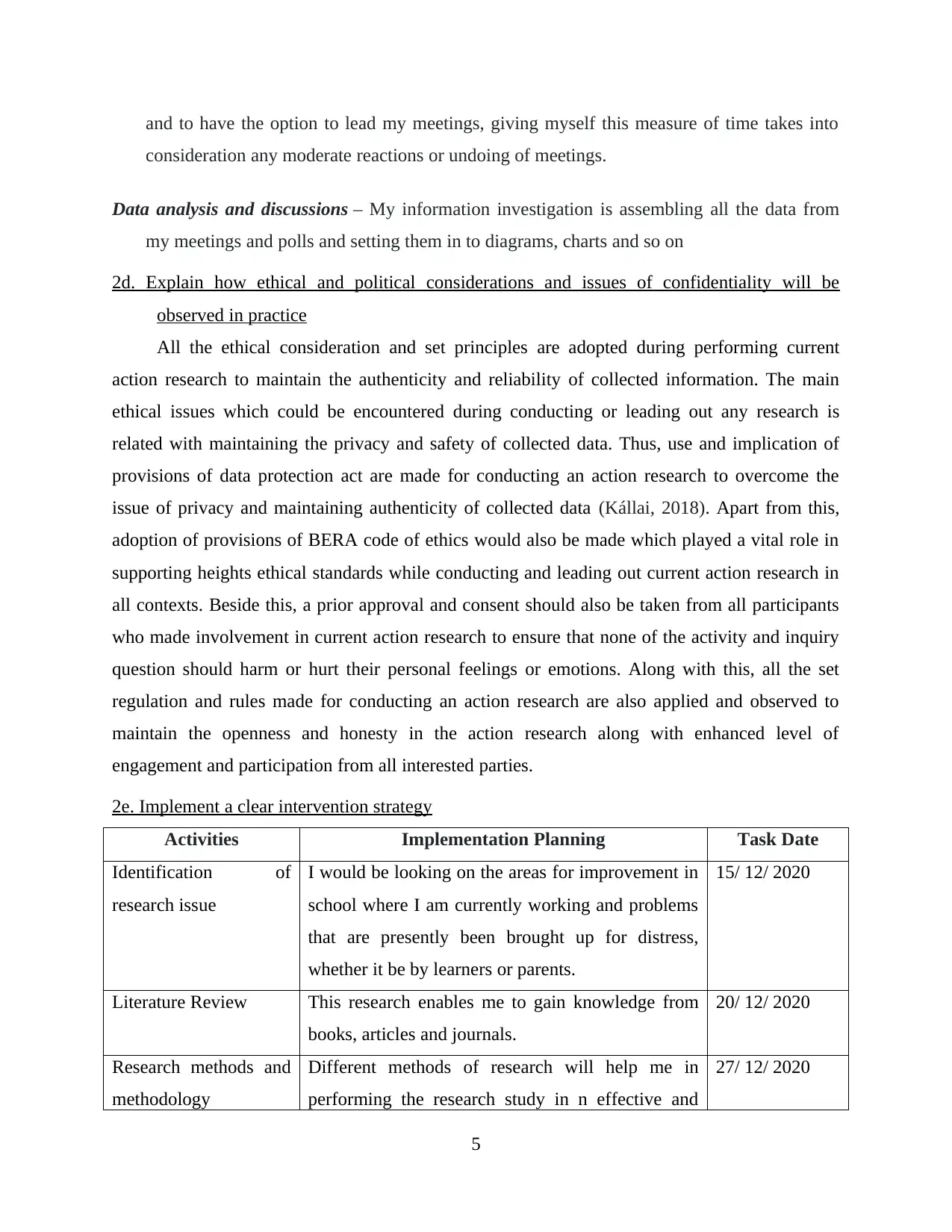
and to have the option to lead my meetings, giving myself this measure of time takes into
consideration any moderate reactions or undoing of meetings.
Data analysis and discussions – My information investigation is assembling all the data from
my meetings and polls and setting them in to diagrams, charts and so on
2d. Explain how ethical and political considerations and issues of confidentiality will be
observed in practice
All the ethical consideration and set principles are adopted during performing current
action research to maintain the authenticity and reliability of collected information. The main
ethical issues which could be encountered during conducting or leading out any research is
related with maintaining the privacy and safety of collected data. Thus, use and implication of
provisions of data protection act are made for conducting an action research to overcome the
issue of privacy and maintaining authenticity of collected data (Kállai, 2018). Apart from this,
adoption of provisions of BERA code of ethics would also be made which played a vital role in
supporting heights ethical standards while conducting and leading out current action research in
all contexts. Beside this, a prior approval and consent should also be taken from all participants
who made involvement in current action research to ensure that none of the activity and inquiry
question should harm or hurt their personal feelings or emotions. Along with this, all the set
regulation and rules made for conducting an action research are also applied and observed to
maintain the openness and honesty in the action research along with enhanced level of
engagement and participation from all interested parties.
2e. Implement a clear intervention strategy
Activities Implementation Planning Task Date
Identification of
research issue
I would be looking on the areas for improvement in
school where I am currently working and problems
that are presently been brought up for distress,
whether it be by learners or parents.
15/ 12/ 2020
Literature Review This research enables me to gain knowledge from
books, articles and journals.
20/ 12/ 2020
Research methods and
methodology
Different methods of research will help me in
performing the research study in n effective and
27/ 12/ 2020
5
consideration any moderate reactions or undoing of meetings.
Data analysis and discussions – My information investigation is assembling all the data from
my meetings and polls and setting them in to diagrams, charts and so on
2d. Explain how ethical and political considerations and issues of confidentiality will be
observed in practice
All the ethical consideration and set principles are adopted during performing current
action research to maintain the authenticity and reliability of collected information. The main
ethical issues which could be encountered during conducting or leading out any research is
related with maintaining the privacy and safety of collected data. Thus, use and implication of
provisions of data protection act are made for conducting an action research to overcome the
issue of privacy and maintaining authenticity of collected data (Kállai, 2018). Apart from this,
adoption of provisions of BERA code of ethics would also be made which played a vital role in
supporting heights ethical standards while conducting and leading out current action research in
all contexts. Beside this, a prior approval and consent should also be taken from all participants
who made involvement in current action research to ensure that none of the activity and inquiry
question should harm or hurt their personal feelings or emotions. Along with this, all the set
regulation and rules made for conducting an action research are also applied and observed to
maintain the openness and honesty in the action research along with enhanced level of
engagement and participation from all interested parties.
2e. Implement a clear intervention strategy
Activities Implementation Planning Task Date
Identification of
research issue
I would be looking on the areas for improvement in
school where I am currently working and problems
that are presently been brought up for distress,
whether it be by learners or parents.
15/ 12/ 2020
Literature Review This research enables me to gain knowledge from
books, articles and journals.
20/ 12/ 2020
Research methods and
methodology
Different methods of research will help me in
performing the research study in n effective and
27/ 12/ 2020
5
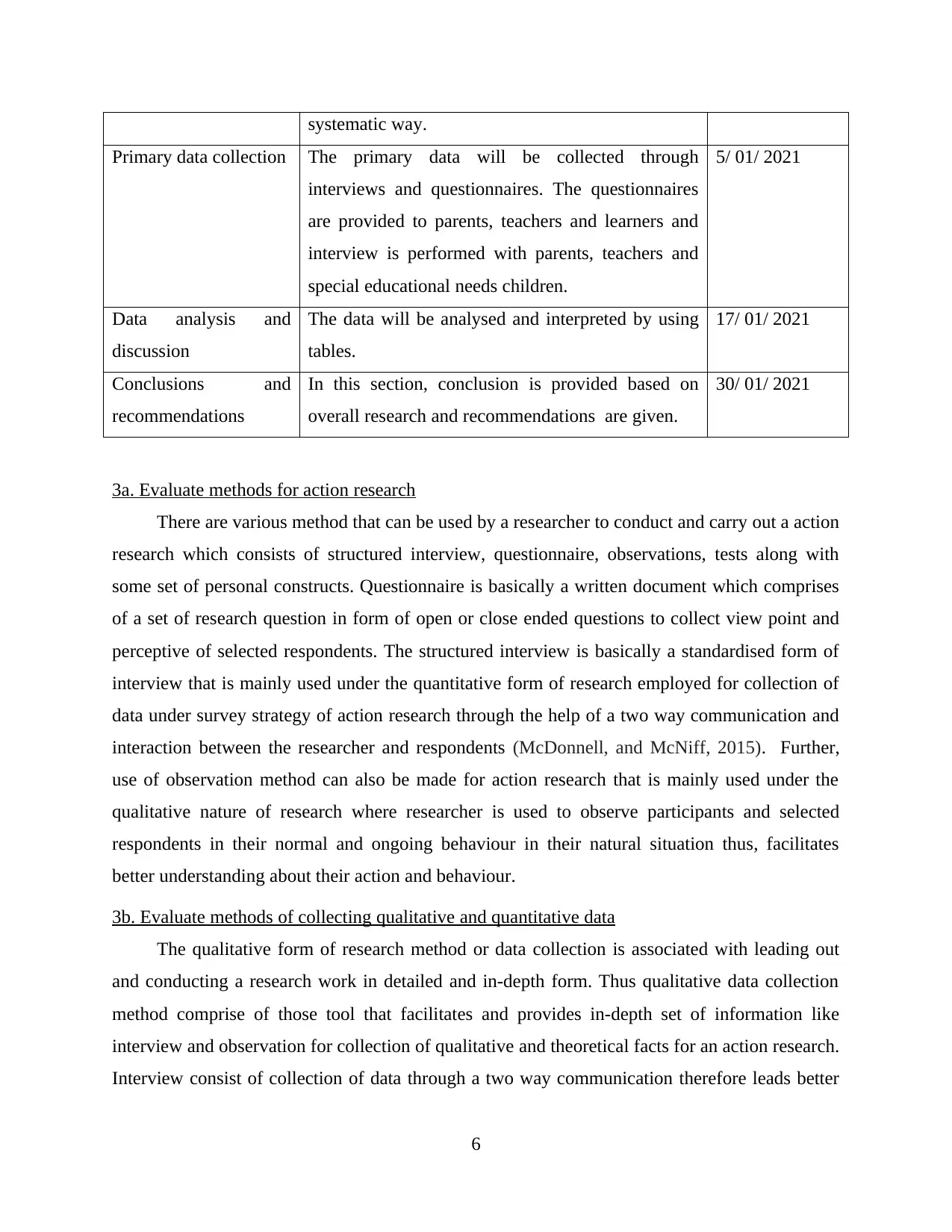
systematic way.
Primary data collection The primary data will be collected through
interviews and questionnaires. The questionnaires
are provided to parents, teachers and learners and
interview is performed with parents, teachers and
special educational needs children.
5/ 01/ 2021
Data analysis and
discussion
The data will be analysed and interpreted by using
tables.
17/ 01/ 2021
Conclusions and
recommendations
In this section, conclusion is provided based on
overall research and recommendations are given.
30/ 01/ 2021
3a. Evaluate methods for action research
There are various method that can be used by a researcher to conduct and carry out a action
research which consists of structured interview, questionnaire, observations, tests along with
some set of personal constructs. Questionnaire is basically a written document which comprises
of a set of research question in form of open or close ended questions to collect view point and
perceptive of selected respondents. The structured interview is basically a standardised form of
interview that is mainly used under the quantitative form of research employed for collection of
data under survey strategy of action research through the help of a two way communication and
interaction between the researcher and respondents (McDonnell, and McNiff, 2015). Further,
use of observation method can also be made for action research that is mainly used under the
qualitative nature of research where researcher is used to observe participants and selected
respondents in their normal and ongoing behaviour in their natural situation thus, facilitates
better understanding about their action and behaviour.
3b. Evaluate methods of collecting qualitative and quantitative data
The qualitative form of research method or data collection is associated with leading out
and conducting a research work in detailed and in-depth form. Thus qualitative data collection
method comprise of those tool that facilitates and provides in-depth set of information like
interview and observation for collection of qualitative and theoretical facts for an action research.
Interview consist of collection of data through a two way communication therefore leads better
6
Primary data collection The primary data will be collected through
interviews and questionnaires. The questionnaires
are provided to parents, teachers and learners and
interview is performed with parents, teachers and
special educational needs children.
5/ 01/ 2021
Data analysis and
discussion
The data will be analysed and interpreted by using
tables.
17/ 01/ 2021
Conclusions and
recommendations
In this section, conclusion is provided based on
overall research and recommendations are given.
30/ 01/ 2021
3a. Evaluate methods for action research
There are various method that can be used by a researcher to conduct and carry out a action
research which consists of structured interview, questionnaire, observations, tests along with
some set of personal constructs. Questionnaire is basically a written document which comprises
of a set of research question in form of open or close ended questions to collect view point and
perceptive of selected respondents. The structured interview is basically a standardised form of
interview that is mainly used under the quantitative form of research employed for collection of
data under survey strategy of action research through the help of a two way communication and
interaction between the researcher and respondents (McDonnell, and McNiff, 2015). Further,
use of observation method can also be made for action research that is mainly used under the
qualitative nature of research where researcher is used to observe participants and selected
respondents in their normal and ongoing behaviour in their natural situation thus, facilitates
better understanding about their action and behaviour.
3b. Evaluate methods of collecting qualitative and quantitative data
The qualitative form of research method or data collection is associated with leading out
and conducting a research work in detailed and in-depth form. Thus qualitative data collection
method comprise of those tool that facilitates and provides in-depth set of information like
interview and observation for collection of qualitative and theoretical facts for an action research.
Interview consist of collection of data through a two way communication therefore leads better
6
⊘ This is a preview!⊘
Do you want full access?
Subscribe today to unlock all pages.

Trusted by 1+ million students worldwide
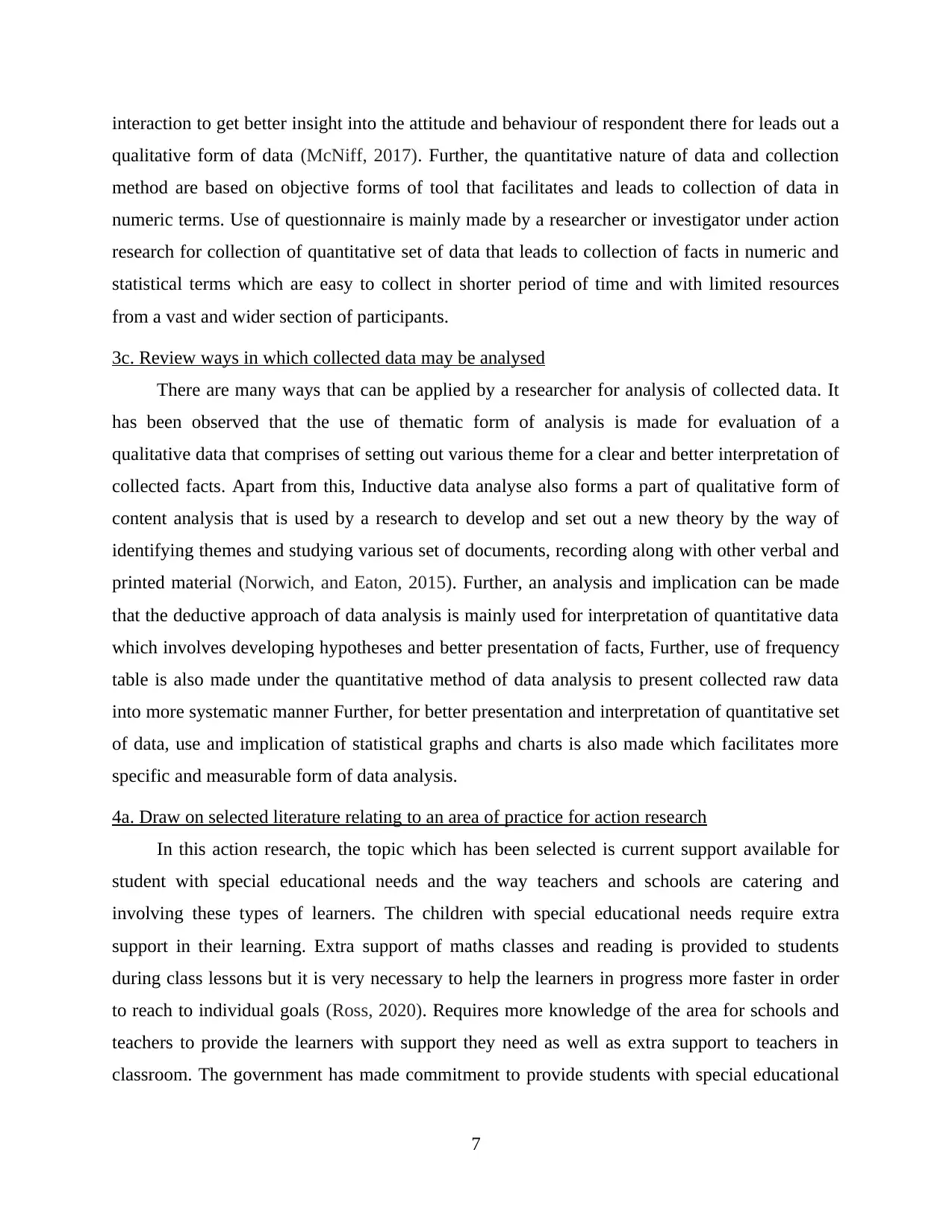
interaction to get better insight into the attitude and behaviour of respondent there for leads out a
qualitative form of data (McNiff, 2017). Further, the quantitative nature of data and collection
method are based on objective forms of tool that facilitates and leads to collection of data in
numeric terms. Use of questionnaire is mainly made by a researcher or investigator under action
research for collection of quantitative set of data that leads to collection of facts in numeric and
statistical terms which are easy to collect in shorter period of time and with limited resources
from a vast and wider section of participants.
3c. Review ways in which collected data may be analysed
There are many ways that can be applied by a researcher for analysis of collected data. It
has been observed that the use of thematic form of analysis is made for evaluation of a
qualitative data that comprises of setting out various theme for a clear and better interpretation of
collected facts. Apart from this, Inductive data analyse also forms a part of qualitative form of
content analysis that is used by a research to develop and set out a new theory by the way of
identifying themes and studying various set of documents, recording along with other verbal and
printed material (Norwich, and Eaton, 2015). Further, an analysis and implication can be made
that the deductive approach of data analysis is mainly used for interpretation of quantitative data
which involves developing hypotheses and better presentation of facts, Further, use of frequency
table is also made under the quantitative method of data analysis to present collected raw data
into more systematic manner Further, for better presentation and interpretation of quantitative set
of data, use and implication of statistical graphs and charts is also made which facilitates more
specific and measurable form of data analysis.
4a. Draw on selected literature relating to an area of practice for action research
In this action research, the topic which has been selected is current support available for
student with special educational needs and the way teachers and schools are catering and
involving these types of learners. The children with special educational needs require extra
support in their learning. Extra support of maths classes and reading is provided to students
during class lessons but it is very necessary to help the learners in progress more faster in order
to reach to individual goals (Ross, 2020). Requires more knowledge of the area for schools and
teachers to provide the learners with support they need as well as extra support to teachers in
classroom. The government has made commitment to provide students with special educational
7
qualitative form of data (McNiff, 2017). Further, the quantitative nature of data and collection
method are based on objective forms of tool that facilitates and leads to collection of data in
numeric terms. Use of questionnaire is mainly made by a researcher or investigator under action
research for collection of quantitative set of data that leads to collection of facts in numeric and
statistical terms which are easy to collect in shorter period of time and with limited resources
from a vast and wider section of participants.
3c. Review ways in which collected data may be analysed
There are many ways that can be applied by a researcher for analysis of collected data. It
has been observed that the use of thematic form of analysis is made for evaluation of a
qualitative data that comprises of setting out various theme for a clear and better interpretation of
collected facts. Apart from this, Inductive data analyse also forms a part of qualitative form of
content analysis that is used by a research to develop and set out a new theory by the way of
identifying themes and studying various set of documents, recording along with other verbal and
printed material (Norwich, and Eaton, 2015). Further, an analysis and implication can be made
that the deductive approach of data analysis is mainly used for interpretation of quantitative data
which involves developing hypotheses and better presentation of facts, Further, use of frequency
table is also made under the quantitative method of data analysis to present collected raw data
into more systematic manner Further, for better presentation and interpretation of quantitative set
of data, use and implication of statistical graphs and charts is also made which facilitates more
specific and measurable form of data analysis.
4a. Draw on selected literature relating to an area of practice for action research
In this action research, the topic which has been selected is current support available for
student with special educational needs and the way teachers and schools are catering and
involving these types of learners. The children with special educational needs require extra
support in their learning. Extra support of maths classes and reading is provided to students
during class lessons but it is very necessary to help the learners in progress more faster in order
to reach to individual goals (Ross, 2020). Requires more knowledge of the area for schools and
teachers to provide the learners with support they need as well as extra support to teachers in
classroom. The government has made commitment to provide students with special educational
7
Paraphrase This Document
Need a fresh take? Get an instant paraphrase of this document with our AI Paraphraser
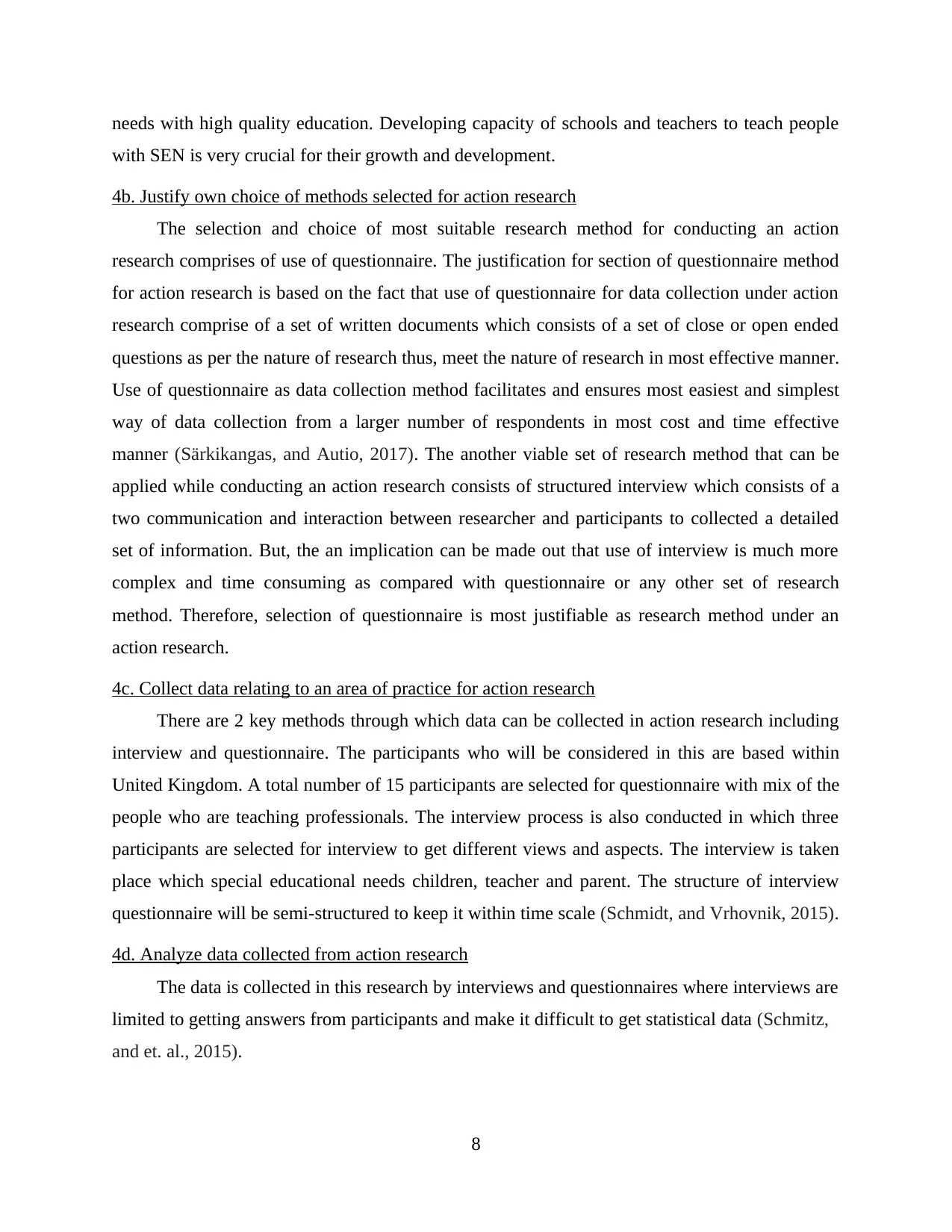
needs with high quality education. Developing capacity of schools and teachers to teach people
with SEN is very crucial for their growth and development.
4b. Justify own choice of methods selected for action research
The selection and choice of most suitable research method for conducting an action
research comprises of use of questionnaire. The justification for section of questionnaire method
for action research is based on the fact that use of questionnaire for data collection under action
research comprise of a set of written documents which consists of a set of close or open ended
questions as per the nature of research thus, meet the nature of research in most effective manner.
Use of questionnaire as data collection method facilitates and ensures most easiest and simplest
way of data collection from a larger number of respondents in most cost and time effective
manner (Särkikangas, and Autio, 2017). The another viable set of research method that can be
applied while conducting an action research consists of structured interview which consists of a
two communication and interaction between researcher and participants to collected a detailed
set of information. But, the an implication can be made out that use of interview is much more
complex and time consuming as compared with questionnaire or any other set of research
method. Therefore, selection of questionnaire is most justifiable as research method under an
action research.
4c. Collect data relating to an area of practice for action research
There are 2 key methods through which data can be collected in action research including
interview and questionnaire. The participants who will be considered in this are based within
United Kingdom. A total number of 15 participants are selected for questionnaire with mix of the
people who are teaching professionals. The interview process is also conducted in which three
participants are selected for interview to get different views and aspects. The interview is taken
place which special educational needs children, teacher and parent. The structure of interview
questionnaire will be semi-structured to keep it within time scale (Schmidt, and Vrhovnik, 2015).
4d. Analyze data collected from action research
The data is collected in this research by interviews and questionnaires where interviews are
limited to getting answers from participants and make it difficult to get statistical data (Schmitz,
and et. al., 2015).
8
with SEN is very crucial for their growth and development.
4b. Justify own choice of methods selected for action research
The selection and choice of most suitable research method for conducting an action
research comprises of use of questionnaire. The justification for section of questionnaire method
for action research is based on the fact that use of questionnaire for data collection under action
research comprise of a set of written documents which consists of a set of close or open ended
questions as per the nature of research thus, meet the nature of research in most effective manner.
Use of questionnaire as data collection method facilitates and ensures most easiest and simplest
way of data collection from a larger number of respondents in most cost and time effective
manner (Särkikangas, and Autio, 2017). The another viable set of research method that can be
applied while conducting an action research consists of structured interview which consists of a
two communication and interaction between researcher and participants to collected a detailed
set of information. But, the an implication can be made out that use of interview is much more
complex and time consuming as compared with questionnaire or any other set of research
method. Therefore, selection of questionnaire is most justifiable as research method under an
action research.
4c. Collect data relating to an area of practice for action research
There are 2 key methods through which data can be collected in action research including
interview and questionnaire. The participants who will be considered in this are based within
United Kingdom. A total number of 15 participants are selected for questionnaire with mix of the
people who are teaching professionals. The interview process is also conducted in which three
participants are selected for interview to get different views and aspects. The interview is taken
place which special educational needs children, teacher and parent. The structure of interview
questionnaire will be semi-structured to keep it within time scale (Schmidt, and Vrhovnik, 2015).
4d. Analyze data collected from action research
The data is collected in this research by interviews and questionnaires where interviews are
limited to getting answers from participants and make it difficult to get statistical data (Schmitz,
and et. al., 2015).
8
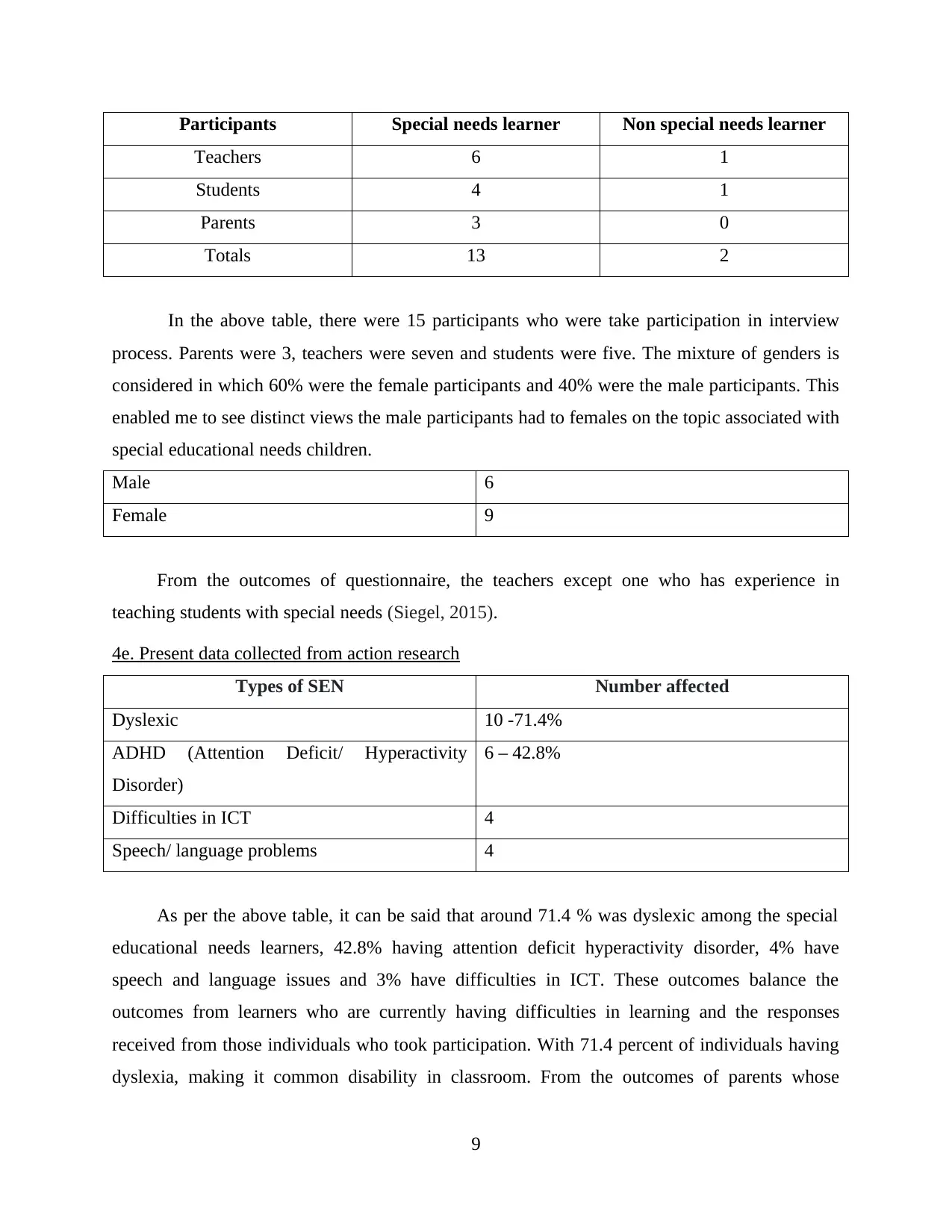
Participants Special needs learner Non special needs learner
Teachers 6 1
Students 4 1
Parents 3 0
Totals 13 2
In the above table, there were 15 participants who were take participation in interview
process. Parents were 3, teachers were seven and students were five. The mixture of genders is
considered in which 60% were the female participants and 40% were the male participants. This
enabled me to see distinct views the male participants had to females on the topic associated with
special educational needs children.
Male 6
Female 9
From the outcomes of questionnaire, the teachers except one who has experience in
teaching students with special needs (Siegel, 2015).
4e. Present data collected from action research
Types of SEN Number affected
Dyslexic 10 -71.4%
ADHD (Attention Deficit/ Hyperactivity
Disorder)
6 – 42.8%
Difficulties in ICT 4
Speech/ language problems 4
As per the above table, it can be said that around 71.4 % was dyslexic among the special
educational needs learners, 42.8% having attention deficit hyperactivity disorder, 4% have
speech and language issues and 3% have difficulties in ICT. These outcomes balance the
outcomes from learners who are currently having difficulties in learning and the responses
received from those individuals who took participation. With 71.4 percent of individuals having
dyslexia, making it common disability in classroom. From the outcomes of parents whose
9
Teachers 6 1
Students 4 1
Parents 3 0
Totals 13 2
In the above table, there were 15 participants who were take participation in interview
process. Parents were 3, teachers were seven and students were five. The mixture of genders is
considered in which 60% were the female participants and 40% were the male participants. This
enabled me to see distinct views the male participants had to females on the topic associated with
special educational needs children.
Male 6
Female 9
From the outcomes of questionnaire, the teachers except one who has experience in
teaching students with special needs (Siegel, 2015).
4e. Present data collected from action research
Types of SEN Number affected
Dyslexic 10 -71.4%
ADHD (Attention Deficit/ Hyperactivity
Disorder)
6 – 42.8%
Difficulties in ICT 4
Speech/ language problems 4
As per the above table, it can be said that around 71.4 % was dyslexic among the special
educational needs learners, 42.8% having attention deficit hyperactivity disorder, 4% have
speech and language issues and 3% have difficulties in ICT. These outcomes balance the
outcomes from learners who are currently having difficulties in learning and the responses
received from those individuals who took participation. With 71.4 percent of individuals having
dyslexia, making it common disability in classroom. From the outcomes of parents whose
9
⊘ This is a preview!⊘
Do you want full access?
Subscribe today to unlock all pages.

Trusted by 1+ million students worldwide
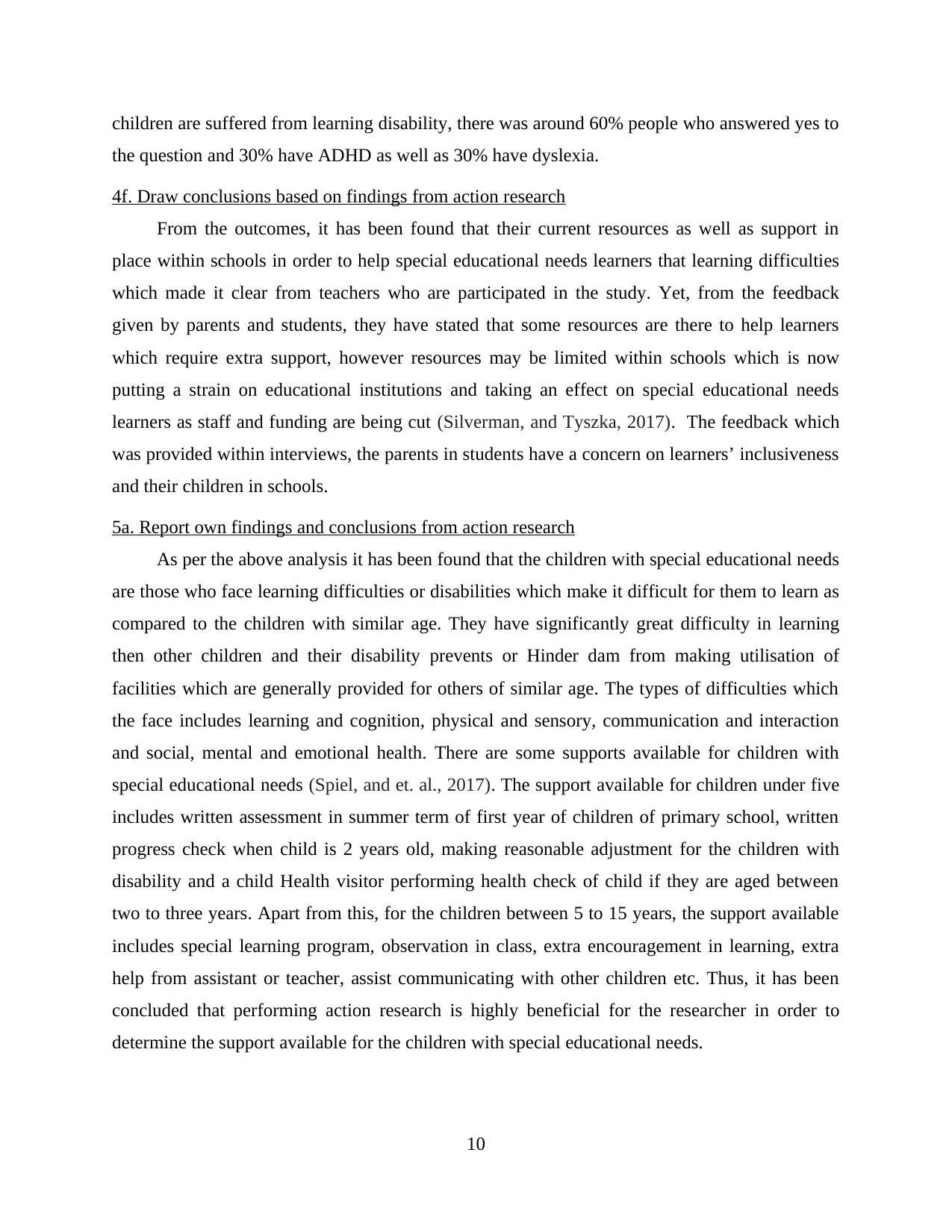
children are suffered from learning disability, there was around 60% people who answered yes to
the question and 30% have ADHD as well as 30% have dyslexia.
4f. Draw conclusions based on findings from action research
From the outcomes, it has been found that their current resources as well as support in
place within schools in order to help special educational needs learners that learning difficulties
which made it clear from teachers who are participated in the study. Yet, from the feedback
given by parents and students, they have stated that some resources are there to help learners
which require extra support, however resources may be limited within schools which is now
putting a strain on educational institutions and taking an effect on special educational needs
learners as staff and funding are being cut (Silverman, and Tyszka, 2017). The feedback which
was provided within interviews, the parents in students have a concern on learners’ inclusiveness
and their children in schools.
5a. Report own findings and conclusions from action research
As per the above analysis it has been found that the children with special educational needs
are those who face learning difficulties or disabilities which make it difficult for them to learn as
compared to the children with similar age. They have significantly great difficulty in learning
then other children and their disability prevents or Hinder dam from making utilisation of
facilities which are generally provided for others of similar age. The types of difficulties which
the face includes learning and cognition, physical and sensory, communication and interaction
and social, mental and emotional health. There are some supports available for children with
special educational needs (Spiel, and et. al., 2017). The support available for children under five
includes written assessment in summer term of first year of children of primary school, written
progress check when child is 2 years old, making reasonable adjustment for the children with
disability and a child Health visitor performing health check of child if they are aged between
two to three years. Apart from this, for the children between 5 to 15 years, the support available
includes special learning program, observation in class, extra encouragement in learning, extra
help from assistant or teacher, assist communicating with other children etc. Thus, it has been
concluded that performing action research is highly beneficial for the researcher in order to
determine the support available for the children with special educational needs.
10
the question and 30% have ADHD as well as 30% have dyslexia.
4f. Draw conclusions based on findings from action research
From the outcomes, it has been found that their current resources as well as support in
place within schools in order to help special educational needs learners that learning difficulties
which made it clear from teachers who are participated in the study. Yet, from the feedback
given by parents and students, they have stated that some resources are there to help learners
which require extra support, however resources may be limited within schools which is now
putting a strain on educational institutions and taking an effect on special educational needs
learners as staff and funding are being cut (Silverman, and Tyszka, 2017). The feedback which
was provided within interviews, the parents in students have a concern on learners’ inclusiveness
and their children in schools.
5a. Report own findings and conclusions from action research
As per the above analysis it has been found that the children with special educational needs
are those who face learning difficulties or disabilities which make it difficult for them to learn as
compared to the children with similar age. They have significantly great difficulty in learning
then other children and their disability prevents or Hinder dam from making utilisation of
facilities which are generally provided for others of similar age. The types of difficulties which
the face includes learning and cognition, physical and sensory, communication and interaction
and social, mental and emotional health. There are some supports available for children with
special educational needs (Spiel, and et. al., 2017). The support available for children under five
includes written assessment in summer term of first year of children of primary school, written
progress check when child is 2 years old, making reasonable adjustment for the children with
disability and a child Health visitor performing health check of child if they are aged between
two to three years. Apart from this, for the children between 5 to 15 years, the support available
includes special learning program, observation in class, extra encouragement in learning, extra
help from assistant or teacher, assist communicating with other children etc. Thus, it has been
concluded that performing action research is highly beneficial for the researcher in order to
determine the support available for the children with special educational needs.
10
Paraphrase This Document
Need a fresh take? Get an instant paraphrase of this document with our AI Paraphraser
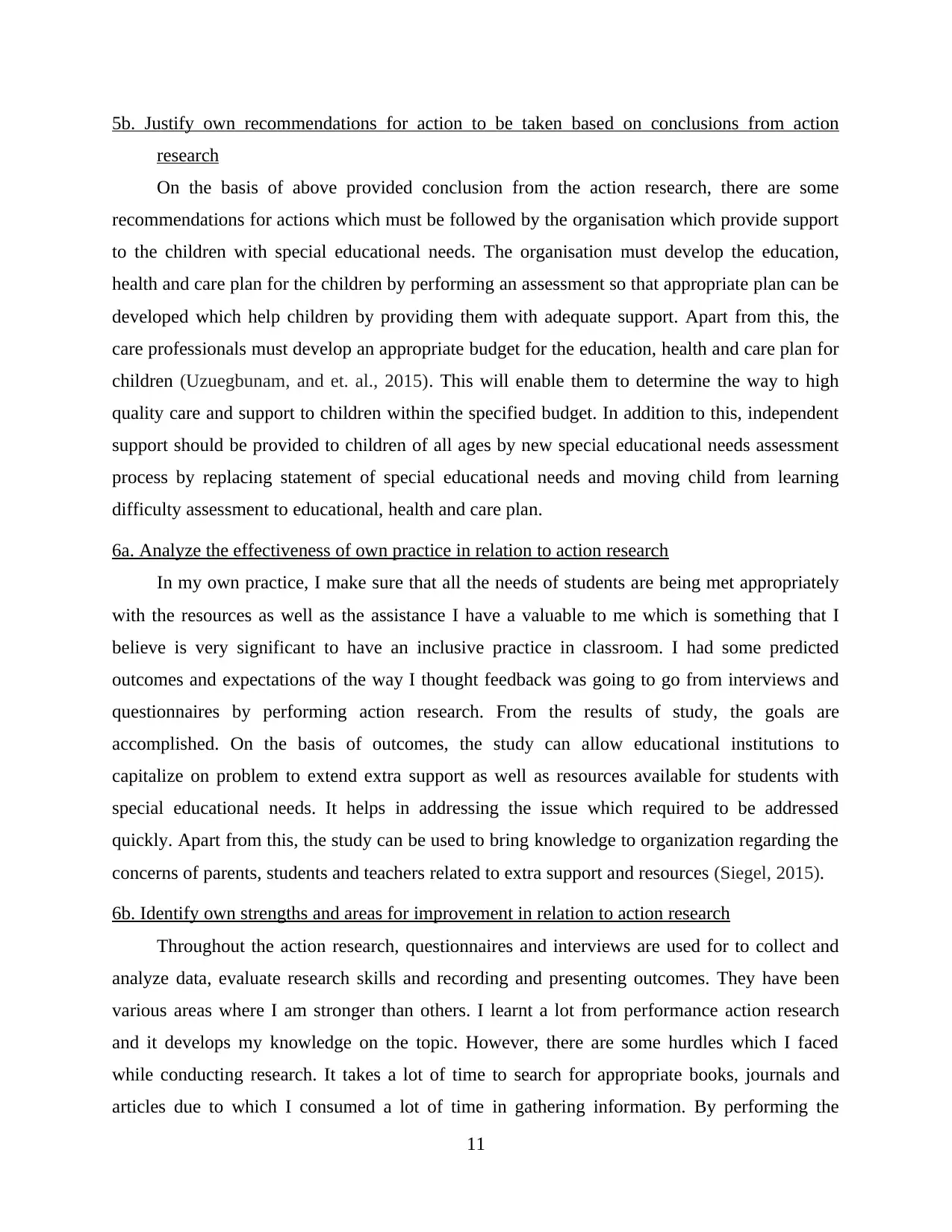
5b. Justify own recommendations for action to be taken based on conclusions from action
research
On the basis of above provided conclusion from the action research, there are some
recommendations for actions which must be followed by the organisation which provide support
to the children with special educational needs. The organisation must develop the education,
health and care plan for the children by performing an assessment so that appropriate plan can be
developed which help children by providing them with adequate support. Apart from this, the
care professionals must develop an appropriate budget for the education, health and care plan for
children (Uzuegbunam, and et. al., 2015). This will enable them to determine the way to high
quality care and support to children within the specified budget. In addition to this, independent
support should be provided to children of all ages by new special educational needs assessment
process by replacing statement of special educational needs and moving child from learning
difficulty assessment to educational, health and care plan.
6a. Analyze the effectiveness of own practice in relation to action research
In my own practice, I make sure that all the needs of students are being met appropriately
with the resources as well as the assistance I have a valuable to me which is something that I
believe is very significant to have an inclusive practice in classroom. I had some predicted
outcomes and expectations of the way I thought feedback was going to go from interviews and
questionnaires by performing action research. From the results of study, the goals are
accomplished. On the basis of outcomes, the study can allow educational institutions to
capitalize on problem to extend extra support as well as resources available for students with
special educational needs. It helps in addressing the issue which required to be addressed
quickly. Apart from this, the study can be used to bring knowledge to organization regarding the
concerns of parents, students and teachers related to extra support and resources (Siegel, 2015).
6b. Identify own strengths and areas for improvement in relation to action research
Throughout the action research, questionnaires and interviews are used for to collect and
analyze data, evaluate research skills and recording and presenting outcomes. They have been
various areas where I am stronger than others. I learnt a lot from performance action research
and it develops my knowledge on the topic. However, there are some hurdles which I faced
while conducting research. It takes a lot of time to search for appropriate books, journals and
articles due to which I consumed a lot of time in gathering information. By performing the
11
research
On the basis of above provided conclusion from the action research, there are some
recommendations for actions which must be followed by the organisation which provide support
to the children with special educational needs. The organisation must develop the education,
health and care plan for the children by performing an assessment so that appropriate plan can be
developed which help children by providing them with adequate support. Apart from this, the
care professionals must develop an appropriate budget for the education, health and care plan for
children (Uzuegbunam, and et. al., 2015). This will enable them to determine the way to high
quality care and support to children within the specified budget. In addition to this, independent
support should be provided to children of all ages by new special educational needs assessment
process by replacing statement of special educational needs and moving child from learning
difficulty assessment to educational, health and care plan.
6a. Analyze the effectiveness of own practice in relation to action research
In my own practice, I make sure that all the needs of students are being met appropriately
with the resources as well as the assistance I have a valuable to me which is something that I
believe is very significant to have an inclusive practice in classroom. I had some predicted
outcomes and expectations of the way I thought feedback was going to go from interviews and
questionnaires by performing action research. From the results of study, the goals are
accomplished. On the basis of outcomes, the study can allow educational institutions to
capitalize on problem to extend extra support as well as resources available for students with
special educational needs. It helps in addressing the issue which required to be addressed
quickly. Apart from this, the study can be used to bring knowledge to organization regarding the
concerns of parents, students and teachers related to extra support and resources (Siegel, 2015).
6b. Identify own strengths and areas for improvement in relation to action research
Throughout the action research, questionnaires and interviews are used for to collect and
analyze data, evaluate research skills and recording and presenting outcomes. They have been
various areas where I am stronger than others. I learnt a lot from performance action research
and it develops my knowledge on the topic. However, there are some hurdles which I faced
while conducting research. It takes a lot of time to search for appropriate books, journals and
articles due to which I consumed a lot of time in gathering information. By performing the
11
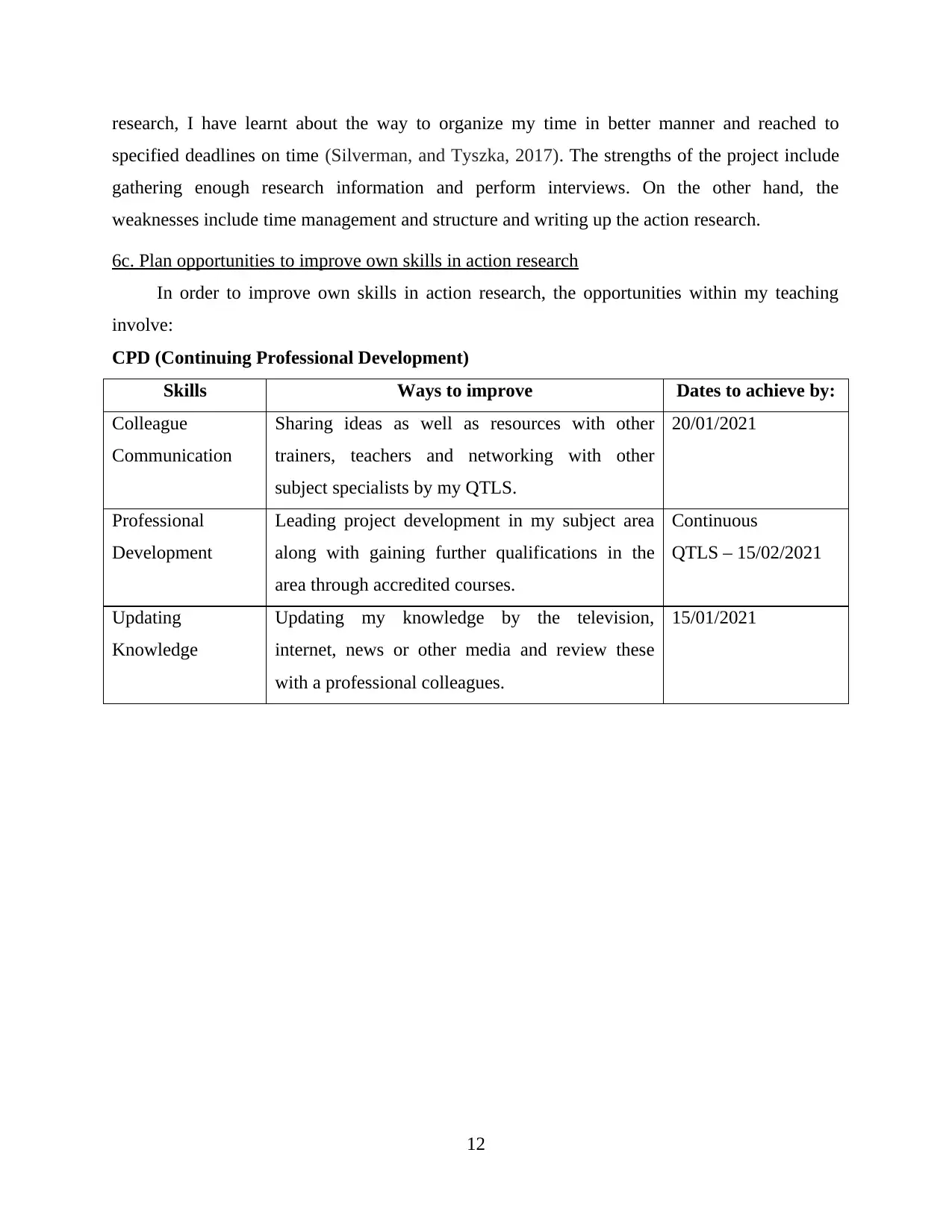
research, I have learnt about the way to organize my time in better manner and reached to
specified deadlines on time (Silverman, and Tyszka, 2017). The strengths of the project include
gathering enough research information and perform interviews. On the other hand, the
weaknesses include time management and structure and writing up the action research.
6c. Plan opportunities to improve own skills in action research
In order to improve own skills in action research, the opportunities within my teaching
involve:
CPD (Continuing Professional Development)
Skills Ways to improve Dates to achieve by:
Colleague
Communication
Sharing ideas as well as resources with other
trainers, teachers and networking with other
subject specialists by my QTLS.
20/01/2021
Professional
Development
Leading project development in my subject area
along with gaining further qualifications in the
area through accredited courses.
Continuous
QTLS – 15/02/2021
Updating
Knowledge
Updating my knowledge by the television,
internet, news or other media and review these
with a professional colleagues.
15/01/2021
12
specified deadlines on time (Silverman, and Tyszka, 2017). The strengths of the project include
gathering enough research information and perform interviews. On the other hand, the
weaknesses include time management and structure and writing up the action research.
6c. Plan opportunities to improve own skills in action research
In order to improve own skills in action research, the opportunities within my teaching
involve:
CPD (Continuing Professional Development)
Skills Ways to improve Dates to achieve by:
Colleague
Communication
Sharing ideas as well as resources with other
trainers, teachers and networking with other
subject specialists by my QTLS.
20/01/2021
Professional
Development
Leading project development in my subject area
along with gaining further qualifications in the
area through accredited courses.
Continuous
QTLS – 15/02/2021
Updating
Knowledge
Updating my knowledge by the television,
internet, news or other media and review these
with a professional colleagues.
15/01/2021
12
⊘ This is a preview!⊘
Do you want full access?
Subscribe today to unlock all pages.

Trusted by 1+ million students worldwide
1 out of 14
Related Documents
Your All-in-One AI-Powered Toolkit for Academic Success.
+13062052269
info@desklib.com
Available 24*7 on WhatsApp / Email
![[object Object]](/_next/static/media/star-bottom.7253800d.svg)
Unlock your academic potential
Copyright © 2020–2025 A2Z Services. All Rights Reserved. Developed and managed by ZUCOL.





